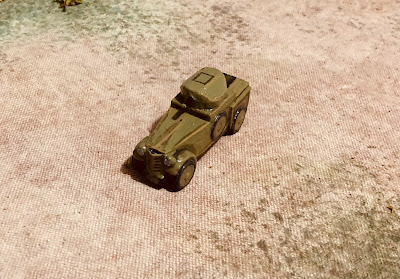This battle, part of the ancients campaign, takes place near the town of Ardea in southern Italy, 209 BC. This campaign turn sees the entry of Scipio the Younger on the scene. Can he change Rome's fortunes?
A previous post briefly covers the games setup and campaign background, but for more information of the step by step process for selection of terrain, troops, chance cards and deployment for a battle, see here - setup process.
Battle Report
Having deployed their troops first Carthage had the advantage of being able to move first. However, a confusion chance card was drawn which meant they were unable to move the first turn. Rome did not hesitate and used this unexpected turn of events to push forward on their stronger right flank. Soon there after most units in the first battle lines were engaged for both armies.
 |
The armies deployed.
|
 |
| Both armies make early advances in the centre and on their stronger flanks. |
 |
| Rome pushes on her strong right flank, while Carthage attempt to flank on the other flank. |
Mid-way through the battle both sides had used their rally chance cards to shore up their centre. The advantage was slightly with the Carthaginian army as the elephants were still causing problems, but Rome's heavy infantry on their right flank, which had quickly disposed of the Gauls, were continuing to cause casualties and looking threatening.
 |
| The elephants are well trained and are continuing to make inroads in the centre. |
 |
| The battle is still evenly balanced at this point mid-way through the game. |
Rome was holding their own and was looking threatening down the right flank. Then they drew two confusion cards in a row. Not being able to move units for two turns meant they were not apply pressure on their attacking flank. This allowed Hannibal to reorganise his units on the right, while continuing his left flank attack with renewed vigour.
 |
| Just as Rome's strong right flank looked to capitalise on their advance they are hamstrung with two confusion chance cards one after the other. |
 |
With Roman forces confused, Hannibal reorganised his forces to counter the flank threat and renewed the attacks on his right flank.
|
 |
| The threat from Rome's right flank is countered. |
The later part of the battle had Carthaginian unit grind down their opposition. The earlier Roman confusion had presented an opportunity for victory that was capitalised on.
 |
| Things are looking bleak for Scipio the Younger. |
 |
| The battle is all over and a victory to Hannibal. |
A Carthaginian victory with fate (in the form a battle setup and chance cards) going their way at critical times. From a Roman perspective Scipio the Younger did not save the day this time. Rome was unlucky in this game losing the choice of deployment and drawing two confusion cards in a row at the height of the battle which really hurt.
What next for the campaign?
Well, with this defeat Rome cannot hope to win the campaign and so the campaign comes to an end. Rome will be negotiating a peace treaty with Carthage.
 |
| Campaign map at the end showing Carthage's dominance |
Campaign Summary
The campaign produced:
- 5 sea battles using simple rules. These games decided which side, Rome or Carthage, moved first of second. The winner moving second which has an advantage because of knowing the other's moves. I enjoyed these games they were a good lead in to each turn.
- 11 land battles. Other than the first campaign turn where 3 battles were fought, all other turns produced 2 battles. All the battles were fought solo with variants of OHW including the use of chance cards. These gave good games with chance cards mixing it up from a solo gamer's perspective.
The campaign began in July 2021 and has taken just over 9 month to complete.
I was pleased to have settled on some deployment rules. This was one area of the games I liked as it gave early decisions for the placement of units:
- Centre or flanks,
- 1st, 2nd or 3rd lines
The importance of a unit's position increased when the unit frontage was increased from 8 to 12 inches. Pivoting of units became only practical for units positioned on the flanks and the 3rd line (if the 3rd line remained in place as the other lines advanced).
 |
| Deployment rules |
Finalised the approach for tabletop terrain setup. I used terrain cards, but changed the approach I used with my ECW campaign to make sure the about of terrain was limited and would not overcrowd the armies.
Through out I used chance cards and added rally cards replacing no event cards to represent larger forces. This meant all games were balanced in terms of number of units, 7 per side. I will be using this approach in future campaigns where suitable.
At the start of the campaign I increased the number of bases representing a unit from 2 to 3 giving a unit a 12 inch frontage. This had the effect of making units less manoeuvrable and increasing the importance of a well thought out deployment.


















































